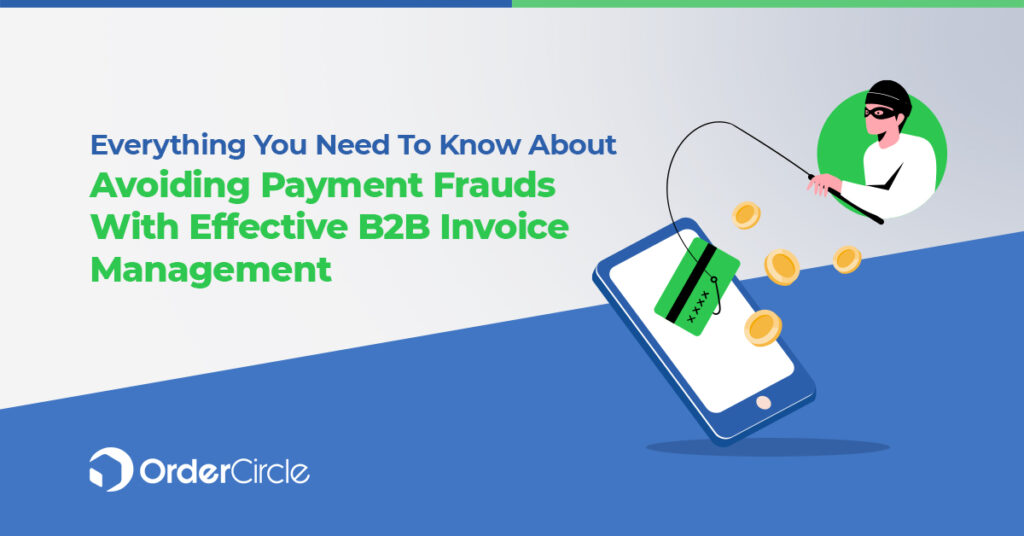Managing payments for B2B businesses has traditionally been done through pen and paper. However, with digitalizing modes of payment, brands may have been quick to adopt it but haven’t been able to make each transaction fully safe and airtight. According to a PYMNTS research, only 30% of executives in an organization are satisfied with their existing billing and payment ecosystems. In addition, 68% intend to incorporate digital-first solutions to address recurring invoicing inconsistencies.
In doing so, one thing that you cannot forget is ensuring the complete safety of data and payment details. Here’s how companies can understand invoicing fraud.
Types of Invoicing Frauds to look out for
To prevent invoicing fraud, let’s start at the very beginning. What are the kinds of invoicing frauds you need to know about?
- Third-Party Invoice Frauds: Commonly takes place when an invoice is made and submitted for products and services that were never delivered in the first place. It could be by hackers, vendors, or even a colluding employee who can ensure the invoice passes through the organization’s accounting system.
- Labor Mischarging: For the purpose of inflating an invoice and raising the payment they receive, vendors may include false information on an invoice regarding the number of employees hired and/or the number of hours worked on an order.
- Fraudulence in Product Quality: Another common type of invoice fraud is when vendors attempt to supply inferior-quality products to purchasers. These tricks, which are frequently very complex, are designed to trick the consumer into thinking that the subpar item is actually genuine.
- Duplicate Invoicing: Paying duplicate invoices is one of the biggest expenses that accounts payable teams face. But vendor theft isn’t always the cause of them. If there has been a payment delay, a seller may occasionally re-submit an invoice. It may also stem from gaps in the accounting team, leading to double payments.
- Internal Invoicing Fraud: According to PWC’s Global Economic Crime and Fraud Survey 2022, 26% of fraud cases result from collusion between internal and external players, and 31% of fraud cases have an internal perpetrator. Although most businesses are conscious that there is a risk of invoice fraud, few take any steps to guard against it because most external fraud comes from vendors.
3 Crucial Ways to prevent an Invoice Fraud
When a company is informed about the different kinds of invoice fraud that exist, there are some crucial steps that should be taken to stop it from happening.
- Invest in an automated B2B Invoice Management System
The most thorough method of processing a vendor invoice and a great way to validate various links in the supply chain is the process of matching an invoice to a PO and accompanying goods receipt note (GRN). You have a much lower chance of paying a phony invoice if you can match all three papers.
When the matching process is automated, the software will highlight any invoice data that is missing, inconsistent, or resembles another invoice that has already been through the matching process. This will enable the accounting team to look into the problem before the invoice is submitted for approval.
An automated solution like ours simplifies invoice management further with:
- Customizations for invoices
- Eliminating confusion by adding payment slips with each order
- Easy invoice generation on the portal in PDF form.
- Conducting Vendor Due Diligence
Fraudulent vendor invoices can frequently be avoided beginning with the selection and onboarding of suppliers. You need to perform a number of due diligence reviews when onboarding vendors.
These actions consist of the following:
- Making sure you follow all necessary procedures to confirm the legitimacy of the provider
- Ensure they deliver a certificate of incorporation
- Check that the TAX/VAT number matches the information given
- Ask for proof of bank account information, and,
- Verify the validity of their email address.
In the US, these due diligence checks might also involve making sure the vendor is not listed on any sanctions lists that would bar them from doing business.
- Make clear segregation of duties
Allowing the same person to handle and document financial transactions, such as payments, makes it much simpler for them to engage in fraud.
However, segregation of duties is the idea that no one person should be allowed the power to handle two or more sets of duties that are in conflict with one another. Those who file POs cannot authorize invoices in a usual AP function. In the same way, those who choose and hire vendors cannot be held accountable for paying bills.
Additionally, in order to avoid bias, which might lead to fraudulent actions, all actions must be confirmed by or authorized by a different team member.
Look out for these signs to recognize a payment fraud
The final thing you need to know is, in fraudulent situations, you always have the chance to recognize certain signs and prevent invoice fraud on time with the above ways we discussed. Some common signs would include:
- Abnormal volume of activity on the invoice
- Certain invoiced products or services are not accounted for
- There are discrepancies between pay orders and invoices
- An employee behaves erratically
However, the biggest step you can take immediately is to book a call with OrderCircle and understand how automation and better invoice management enable your organization to be prepared for all kinds of situations. Click here to book a free demo call today.

